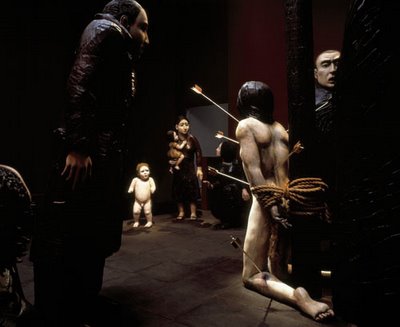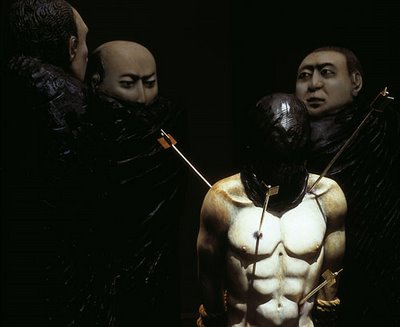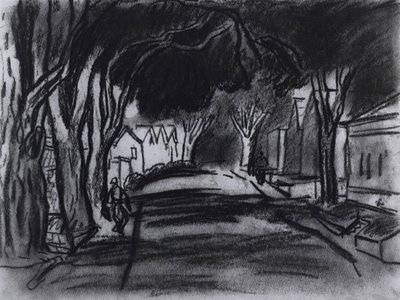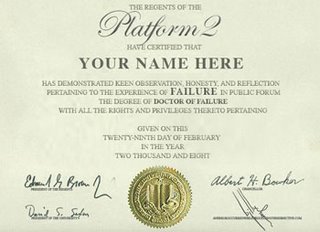The New England chapter of the International Association of Art Critics (AICA) announced its awards for the 2006-’07 season during a ceremony at Brandeis University tonight. The group (of which I’m not a member) has issued awards for the past six years under the leadership of director Francine Koslow Miller, but
she said this would be the group’s last local awards ceremony. That’s sad news. The awards ceremony ain’t perfect (what is?) but it’s one of the few occasions when the greater Boston arts community gets together and celebrates the good things we do around here.
Best historic monographic museum show“Edwin Dickinson in Provincetown: 1912-1937,” Provincetown Art Association and Museum, curator: Mary Abell.
Best historical group museum showFirst place: “Donatello to Giambologna: Italian Renaissance Sculpture,” Museum of Fine Arts, Boston, curator: Marietta Cambareri.
Second place: “Dissent!” Fogg Art Museum, Harvard University, curator: Susan Dackerman.
Best contemporary monographic museum show“Louise Bourgeois: The Woven Child (in context,” Worcester Art Museum, curator: Susan Stoops.
Best thematic museum showFirst place: “Sensorium (I and II),” MIT List Visual Arts Center, curators: Bill Arning, Jane Farver, Yuko Hasegawa and Marjory Jacobson.
Second place: “Super Vision,” ICA Boston, curator: Nicholas Baume.
Best show in a university or college gallery:First place: “Electric Wasteland: Urban Art from L.A.,” Montserrat College of Art, curator: Leonie Bradbury.
Second place: “Picture Show,” Boston University’s Photographic Resource Center as part of the Boston Cyberarts Festival, curator: Leslie K. Brown.
Best monographic show in a commercial galleryFirst place tie: “Tabitha Vevers: Distant Shores,” Pepper Gallery; “Jenny Holzer: Archive,” Barbara Krakow Gallery.
Second place tie: “Neeta Madahar and Rona Pondick: Unnatural,” Howard Yezerski Gallery; “Eisbergfreistadt,” Kahn/Selesnick, Pepper Gallery.
Best group show in a commercial galleryFirst place: “Regional Highlights: Miles Huston, Kate Levant and Jacques Louis Vidal,” LaMontagne Gallery, curator: Justin Lieberman.
Second place: “It’s Not What You Know, It’s Who You Know,” Samson Projects, curator: Camilo Alvarez.
Best show in a public spaceFirst place: “Art on the Harbor Islands,” ICA Boston, curator: Carole Anne Meehan.
Second place: “It Takes 154,000 Breaths to Evacuate Boston,” iKatun, project director: Kanarinka (Catherine D’Ignazio).
Best show in a nonprofit spaceFirst place: “Laura Evans: Seeing Red,” Boston Sculptors Gallery.
Second place: “Encounters,” Boston Center for the Arts’ Mills Gallery as part of the Boston Cyberarts Festival, curator: Femke Lutgerink.
Best architecture or design showFirst place: “Beyond the Harvard Box,” Harvard Graduate School of Design, curator: Michael Meredith.
Second place: “Classified Documents: The Social Museum of Harvard University, 1903-1931,” Arthur M. Sackler Museum, curators: Deborah Martin Kao and Michelle Lamuniere.
Best exhibition of time-based artFirst place “Balance and Power: Performance and Surveillance in Video Art,” Rose Art Museum at Brandeis University, curator: Michael Rush.
Second place: “Brian Knep: Aging,” Judi Rotenberg Gallery as part of the Boston Cyberarts Festival.
AICA distinguished service awardsDr. Katherine (Kay) Sloan, president, Massachusetts College of Art and Design.
Jeff Keogh, director of public art, Massachusetts College of Art and Design.
Winners were selected by AICA New England members Francine Miller (director), Bill Arning, Debra Balken, Susan Boulanger, Christopher Busa, Charles Giuliano, Jennifer Gross, Christian Holland, Barbara O’Brien, Deborah Rothschild, Michael Rush and Mary S. Sherman.
Related:










